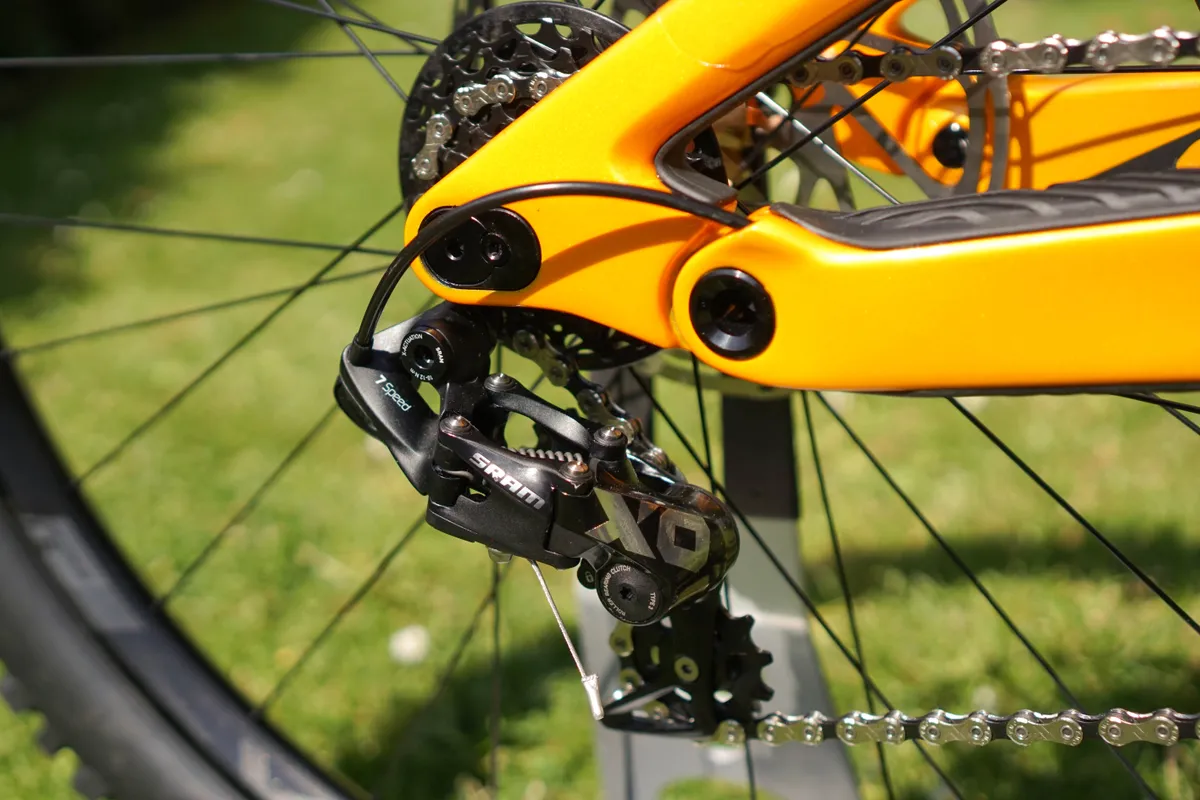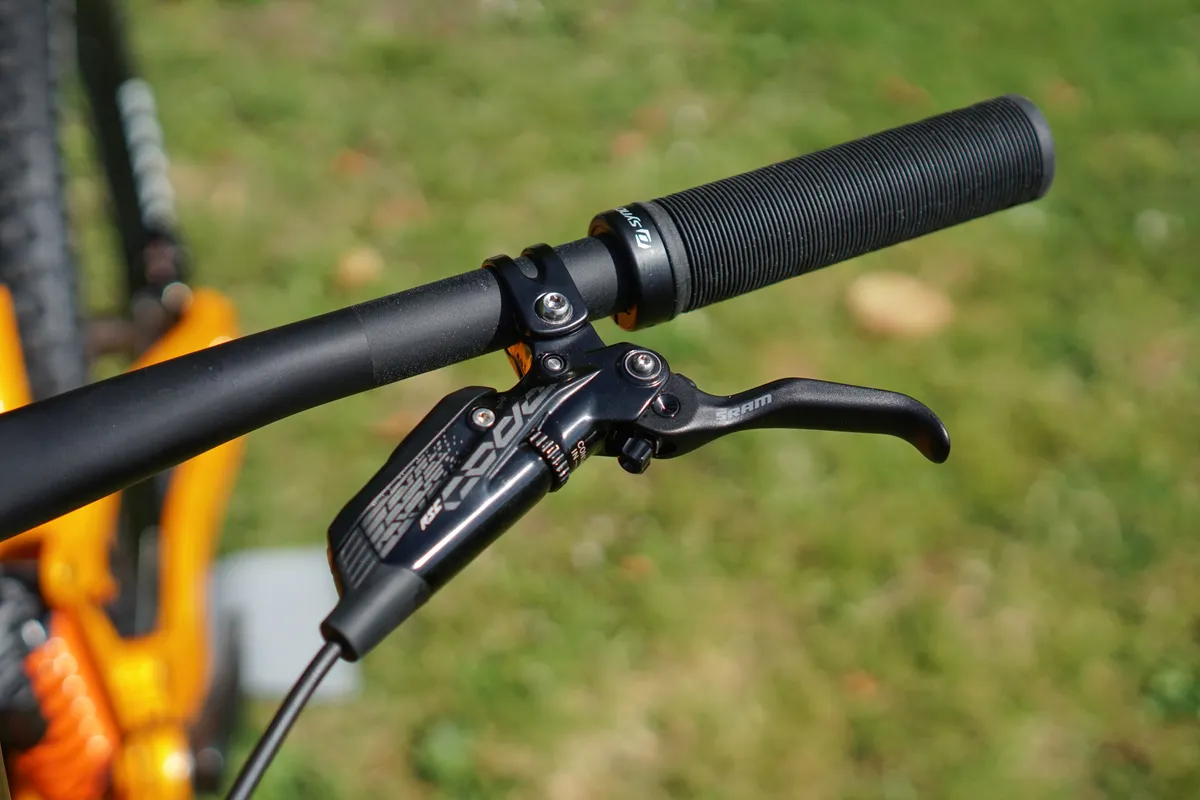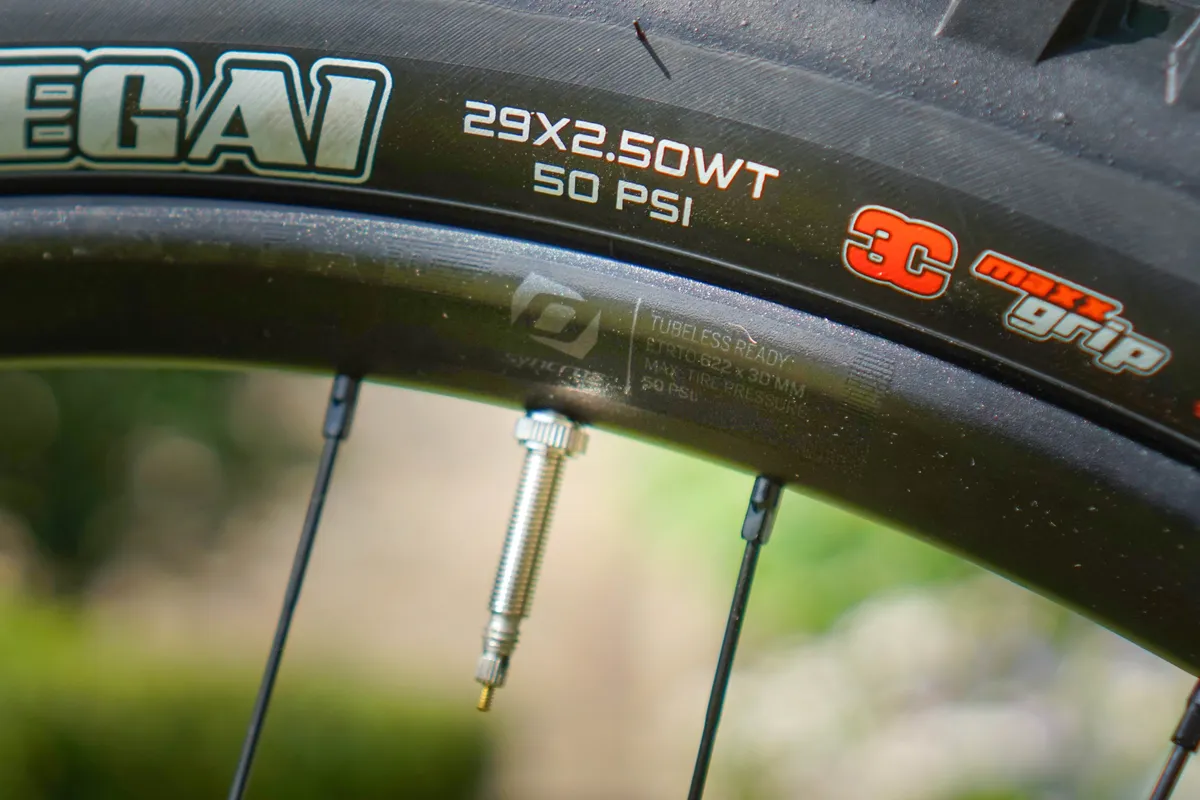The previous iteration of Scott's Gambler first debuted in July 2012 and featured a radical-looking linkage-actuated single pivot. Back then, it also featured a bonkers stock 62-degree head angle that you could adjust with headset cups from 60 to 64 degrees, a high and low shock setting and chainstay length adjustment.
The bike certainly set a new precedent with its adjustability and potential to grab headlines with its geometry figures — even compared to today's bikes.
- Scott Gambler 900 Tuned review
- Rad, red Maverick joins Juliana, and Santa Cruz Hightower gets an update
- Best cycle computer for 2019 | GPS cycle computers for riding, training, touring and navigation
After a few years and several iterations that incrementally increased compatibility for 650b and 29-inch wheels, along with changes to the linkage, it became pretty clear more recently that the Gambler was up for a full refresh.
Scott's recent form shows great promise — the Spark, Genius and Ransom bikes all seem to be pleasing our testers, so we were all excited to see what they'd come up with for the new Gambler that we've seen Brendan Fairclough and the rest of the Scott team racing at world cups over the past year.
2020 Scott Gambler 900 Tuned frame details

The Tuned models in Scott's range sit at the top end of the spectrum, normally made from the highest-tech carbon materials in a bid to create lightweight, maximum performance kit. The 900 bikes across Scott's range usually come equipped with the plushest parts, too. So it's safe to assume that the Gambler 900 Tuned is the range-topping, halo model.
Stiffness was the objective
What tech do you get, then?
Both the front and rear triangles are made from carbon, as is the rocker link. The rocker link uses a traditional carbon layup that, Scott claims, weighs just 160g.
The main frame is made using Scott's Evolap layering technology, which it's manipulated to generate what it claims is a perfect balance between stiffness and compliance.
This balance is carefully generated by managing both lateral and torsional stiffness values. The idea is to maintain torsional stiffness along the bike's length while being able to introduce lateral compliance that should, it claims, reduce rider fatigue.
The latest iteration of the Gambler is the result of plenty of testing, and in a bid to investigate where the right sort of stiffness comes from, Scott built Gamblers in varying frame material configurations.
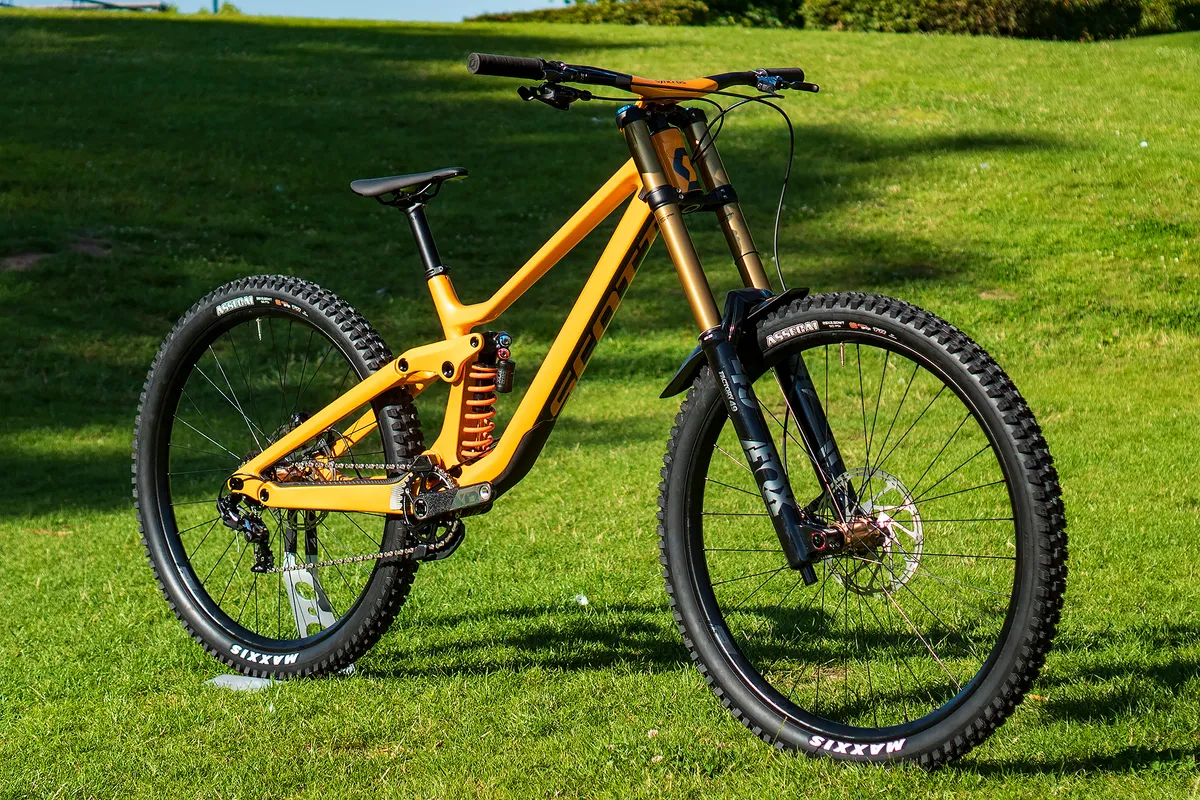
Scott's findings revealed that a bike needs to be consistently stiff from front to back — if the rear end is particularly flexy, but the front is mega stiff, the bike will ride in an unruly way. But if the bike's stiffness is uniform then the bike will corner and ride better.
Scott says it worked hard to create a Goldilocks front to rear stiffness ratio after correlating bench testing with real-life feedback. That particular ratio is on a need to know basis though.
The result is a bike that has boosted torsional stiffness with improved lateral compliance, or at least that's what Scott claims.
The other point it was keen to raise is that the bike's compliance comes from its chassis — particularly the tubes and overall construction — not its pivots or pivot bearings.
The chassis is easier to tune than a joint between two tubes, such as a pivot bearing. It decided to use double row bearings on the pivot that connects the seat and chainstays, and the pivot that attaches the seatstay to the linkage plate. This, it says, should help to improve the stiffness of the pivots.

Thanks to the bike's overall construction Scott was keen to point out that, unlike some other bikes on the market and the previous Gambler, you don't have to ride it to within an inch of its life to get the most from it — it's just as happy cruising as it is being pummeled downhill over the gnarliest terrain by Brendan Fairclough.
Proprietary chain device and bash guard

In a bold but totally understandable move, Scott has decided to ditch the ISCG05 chain device mounting standard with the aim of having more freedom to design the best, strongest and stiffest chainstay to main frame link, shedding weight and not being constrained by the nature of where the mounting holes need to be.
Normally, an engineer is forced to reduce the main pivot's width and then shape the chainstay tube around the ISCG05 mounts, but not so with this proprietary design. The chain device is designed to be run with 32-, 34- or 36-tooth chainrings only.

Scott was also keen to point out that it's not designed and isn't trying to implement a new standard here — the chain device and mounting system are bespoke for the new Gambler, so don't expect to see it popping up on any other manufacturer's bikes.
Doing away with the in-frame threads that add considerable weight to the bike, Scott's new chain device mounts using rubber shock absorbers that should reduce shock transmissions to the frame.
As a bonus, it's possible to remove the chain guide without taking the cranks off or having to creep an Allen key through the holes in the chainring.

The other key benefit is that the main pivot has been made as wide as possible, which should help the bearings to last for longer and make the pivot stiffer.
Scott claims that the whole system weighs 113g. It was also very keen to point out that the chain device and its parts are going to be readily available from Scott's website and retailers, costing €14.90 for the chain device and €19.90 for the bash guard.
Flip chip geometry adjustment and wheelbase options
The new Gambler has an impressive array of geometry adjustment options. There are four different shock mounting points: a high and low mode and more and less progressive modes that can be used in both bottom bracket height settings. Scott's tuning guide has details on which settings are suitable for which tracks.
It's also possible to adjust the bike's wheelbase thanks to two positions on the chainstay for the rear wheel, and Scott says you can use both short and long settings with 29- and 27.5-inch wheels.
The 900 Tuned Gambler comes with a +/- 1-degree headset cup so you can further adjust the geometry, and a plus 15mm stack bottom headset cup if you want to run 27.5-inch wheels to reclaim some of the lost height that you get from changing to 650b from 29-inch hoops.
The devil is in the detail
You also get an integrated carbon down tube protector, internally-routed cables, fork bump stops and driveside chain and seatstay protection to help reduce noise.

2020 Scott Gambler 900 Tuned geometry
- Head tube angle: 62.9 degrees (low setting) / 63.2 degrees (high setting)
- Head tube length: 110mm/4.3in
- Horizontal top tube: 621mm/24.4in (low setting) / 618.9mm/24.4in (high setting)
- Standover: 712.1mm/28in (low setting) / 705.8mm/27.8in (high setting)
- Bottom bracket height: 345.4mm/13.6in (low setting) / 342.6mm/13.5in (high setting)
- Wheelbase: 1,270mm/50in (low setting) / 1,272.8mm/50.1in (high setting)
- Seat angle: 63.8 degrees (low setting) / 64.2 degrees (high setting)
- Chainstay: 438.7mm/17.3in (low setting) / 435mm/17.1in (high setting)
- Reach: 460.4mm/17.3in (low setting) / 465mm/18.3in (high setting)
- Stack: 633.5mm/24.9in (low setting) / 631.3mm/24.9in (high setting)
- *All geometry figures for size large. Low setting for 29-inch wheel. High setting for 27.5-inch wheel.
Thanks to the bike's flip chip, wheelbase adjustment and the headset cups, it's possible to modify the bike's geometry.
The standard bike's figures look good, too, and it's nice to see a long wheelbase figure, a solid reach number and relatively long chainstays that can be made longer.

Seat angle issues
Scott has increased the seat angle on the small and medium bikes to help smaller riders use bigger wheels. It thought that the biggest issue smaller riders had with running 29-inch wheels was that they couldn't get the seat low enough without it buzzing the tyre.
Scott's solution to this problem is neat — essentially the seat has been moved forward away from the rear tyre by increasing the seat tube angle by three degrees on the smaller-sized bikes.

Scott has also designed a custom saddle for the bike that should help to reduce tyre buzz even more.
The seat's rear has been made much shorter to help shorter people feel at home on big wheels. The seat is specced on the Gambler but will feature on the Ransom soon and will be available as an aftermarket purchase in the not too distant future for €99.90 — international pricing TBC.
2020 Scott Gambler 900 Tuned suspension

The most notable change to the Gambler is its silhouette — gone is the intricate linkage of the old bike. It has been replaced with a Horst link system that has the same look and technology as the rest of Scott's full suspension lineup.
With the ultimate aim of reducing anti-rise numbers (how much the bike's suspension squats under braking, effectively countering the forward motion of your mass and preserving your bike's geometry) compared to the old Scott Gambler, the engineers at Scott settled on the Horst-link design that, in this configuration, produces around 40 to 50 percent anti-rise.
The most notable benefit of lower anti-rise is more active suspension under braking, which in theory helps improve control.
Some people disagree with this statement, saying that it's better to preserve the bike's geometry and sacrifice suspension performance under braking because it makes the bike more predictable and reduces the feeling of being pitched forward.
The two trains of thought are at odds with one another, but Scott clearly believes that lower anti-rise numbers are better — the old Gambler had a high figure (around 100 percent), while the new one is reduced.
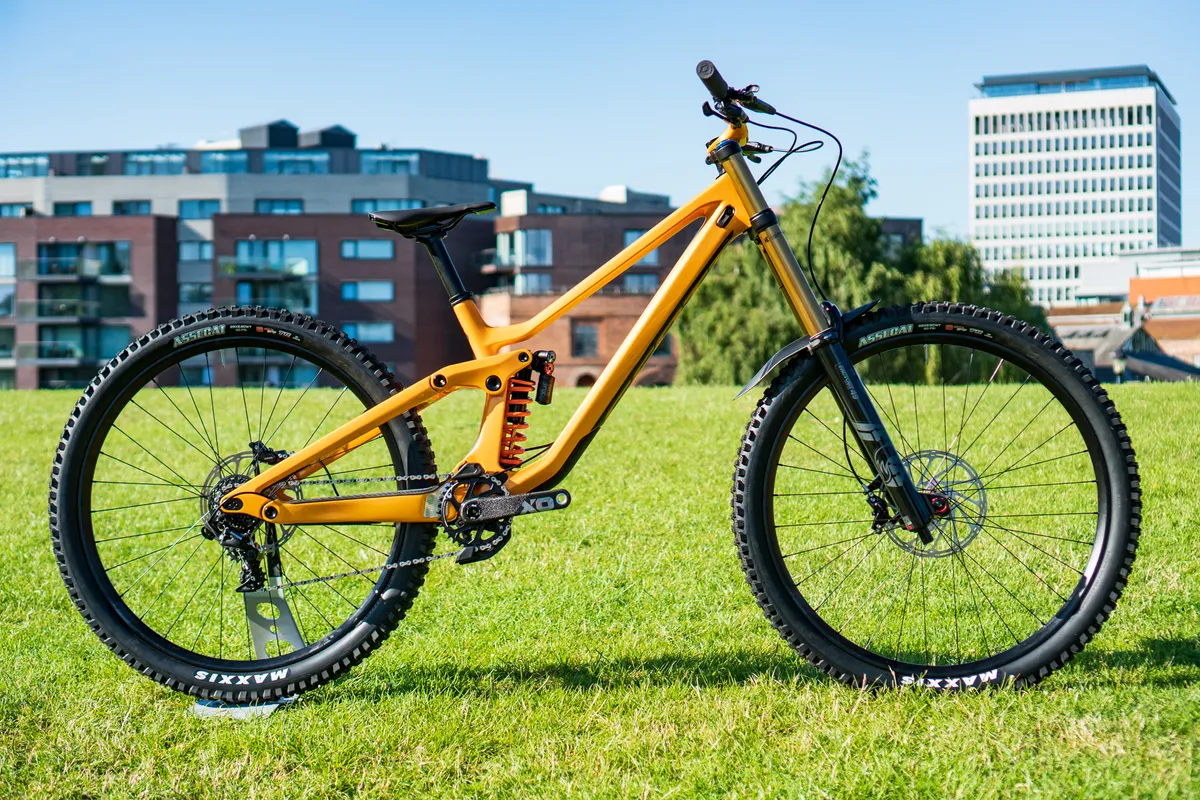
The Horst-link system, it says, is also easy to tune and is structurally efficient, providing a stable and stiff rear end.
It did experiment with high pivot points, and given how popular they've become in recent times we don't blame Scott. Its research concluded that the benefits of a high pivot don't outweigh the pitfalls of designing the system. Plus, high pivot bikes generate high levels of anti-rise, something Scott wanted to avoid.

The adjustable progression rate that's dictated by the flip chip's position changes the bike's progression from 30 percent in the more linear mode to 35 percent in the most progressive mode.
The progression curve is virtually straight for both settings so it makes the shock easier to tune — there are no abrupt changes to the bike's inherent kinematic.
To top it off, if you change the bottom bracket setting from high to low the progression rates remain virtually identical. This also means Scott was able to opt for a coil shock that's inherently more linear than an air-sprung equivalent.
2020 Scott Gambler 900 Tuned specifications and pricing

- Frame: Carbon front and rear, Horst-link suspension, adjustable geometry, 12x157mm dropout, BB107, 27.5- and 29-inch wheels compatible
- Fork: Fox 49 Factory, 203mm travel, Kashima stanchions, GRIP2 damper, 20mm Boost axle
- Rear shock: Fox DH X2 Factory, 225x75mm, 500lbs spring (size large)
- Headset: Syncros DH adjustable +/- 1-degree
- Rear mech: SRAM X01 DH 7-speed
- Shifter: SRAM X01 7-speed
- Brakes: SRAM Code RSC, 200mm rotors (front and rear)
- Cranks: SRAM X01 DUB, 34-tooth chainring, 165mm arm length
- Chain device: Scott DH custom
- Bottom bracket: SRAM DUB MTB107
- Handlebar: Syncros Hixon iC DH carbon, 15mm rise, 8-degree sweep, 800mm wide
- Seatpost: Syncros DH1.5, 31.6 diameter
- Seat: Syncros Comox 1.5, titanium rails
- Chain: KMC X11-1
- Cassette: SRAM CS PG-720 DH 11-25 teeth
- Tyres: Maxxis Assegai 29X2.5-inch, Kevlar bead, DH, TR, 3C Maxx Grip
- Wheels: Syncros Revelstoke DH1.5, 32 spoke, tubeless ready
- Weight: 15.7kg / 34.61lb (size large, without pedals, actual weight)
- Price: €7999
The 900 Tuned model is dripping in the best, latest and highest performing kit around that includes the fantastic 29er Fox 49 fork with the GRIP2 damper, a matching Fox X2 DH rear shock that, like the fork, boasts high- and low-speed compression and rebound adjustment and a thoroughbred selection of SRAM X01 DH drivetrain kit.
You also get DH-casing tyres and a smattering of Syncros (Scott's in-house component manufacturer) parts including seatpost, wheels, bar, stem and saddle.
The all-in-one Hixon iC DH bar and stem combo is quite the looker and as an aftermarket product will set you back €349.90. The one-piece system is seen across Scott's mountain bike and road range under different monikers and it's interesting to see one on a DH bike.
Scott openly admits that it's a love it or hate it affair. There's a lack of bar roll adjustment, so if you're into freaky angles it might not be the one for you.
Syncros has made an integrated front mudguard for the Fox 40 fork that looks incredibly sleek and is compatible with both 27.5- and 29-inch wheeled versions of the fork. The fender will be available to buy aftermarket for €19.90.
2020 Scott Gambler 900 Tuned frame kit

A frame kit of the 900 Tuned version is available and is supplied with headset cups, geometry and suspension kinematic adjustment and chain device. It doesn't come with the Hixon bar or Fox 49 fork, however.

The frame kit retails for €4,199 including shock. The bike will be available to buy in shops from mid-November 2019.






